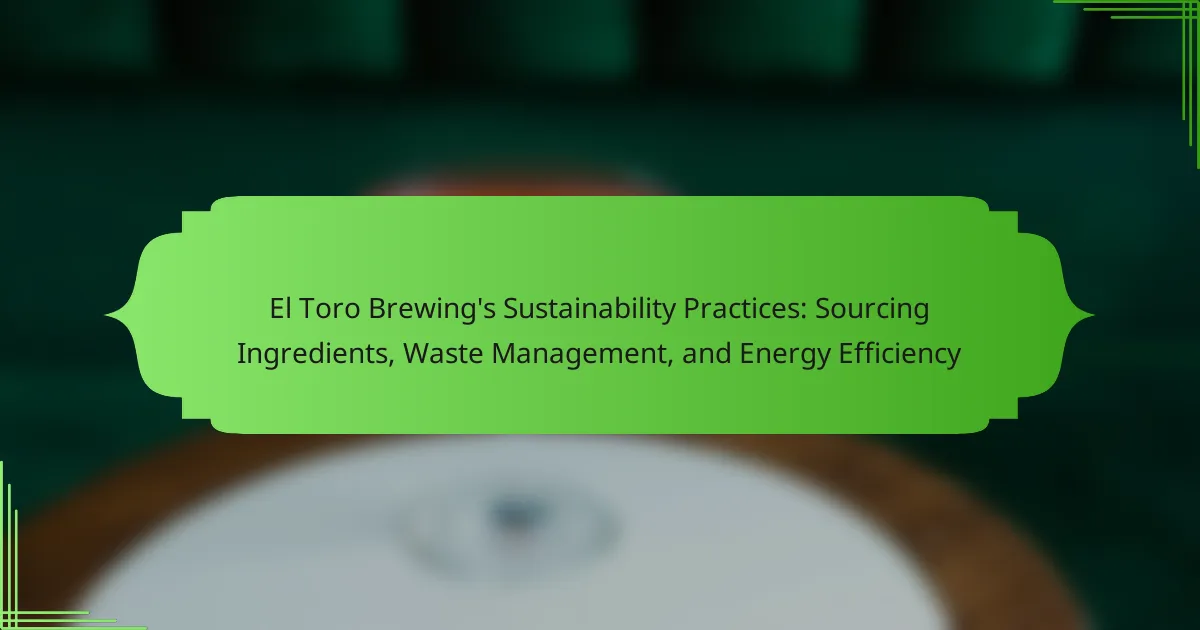Sanitization is a fundamental practice at El Toro Brewing, essential for ensuring product quality and safety. The article examines the importance of sanitization in the brewing process, highlighting methods used to prevent contamination and microbial growth that can spoil beer and alter its flavor. It details the strict sanitization protocols implemented by El Toro Brewing, including the use of food-grade sanitizers and adherence to industry best practices. By maintaining a hygienic brewing environment, these practices contribute significantly to the brewery’s success and reputation while ensuring compliance with health regulations.

What is the role of sanitization in El Toro Brewing?
Sanitization in El Toro Brewing is crucial for maintaining product quality and safety. It prevents contamination that can spoil beer or affect flavor. Regular sanitization of equipment and surfaces ensures a hygienic brewing environment. This practice reduces the risk of microbial growth, which can lead to off-flavors and spoilage. El Toro Brewing implements strict sanitization protocols to comply with health regulations. These protocols include using food-grade sanitizers and following industry best practices. Consistent sanitization contributes to the overall success and reputation of the brewery.
Why is sanitization critical in the brewing process?
Sanitization is critical in the brewing process to prevent contamination. Contaminants such as wild yeast and bacteria can spoil the beer. This leads to off-flavors and can ruin the entire batch. Sanitization ensures that all equipment is free of these unwanted microorganisms. Studies show that proper sanitization can increase the quality and shelf life of beer. For example, the Brewers Association emphasizes that sanitation is vital for maintaining flavor integrity. Regular sanitization practices contribute to consistent brewing results. Therefore, neglecting sanitization can significantly impact the final product.
What are the potential risks of inadequate sanitization?
Inadequate sanitization can lead to serious health risks. Contaminated surfaces can harbor pathogens. These pathogens may cause foodborne illnesses. Symptoms can include nausea, vomiting, and diarrhea. In severe cases, infections can lead to hospitalization. Additionally, inadequate sanitization can compromise product quality. This can result in spoilage and off-flavors in beverages. Furthermore, poor sanitization practices can damage a brand’s reputation. Customers may lose trust and choose competitors instead.
How does sanitization impact the quality of the final product?
Sanitization directly impacts the quality of the final product by reducing microbial contamination. Effective sanitization ensures that harmful bacteria and pathogens are eliminated from brewing equipment. This process prevents spoilage and off-flavors that can arise from microbial growth. Research shows that proper sanitization can enhance the shelf life of the product. It also contributes to the consistency of flavor and aroma in the final brew. Studies indicate that breweries with rigorous sanitization protocols produce higher quality beers. For instance, the Brewers Association highlights that sanitation is crucial for maintaining product integrity. Thus, sanitization is essential for achieving high-quality outcomes in brewing.
What methods of sanitization are utilized at El Toro Brewing?
El Toro Brewing utilizes several methods of sanitization to ensure a clean brewing environment. These methods include chemical sanitizers, heat sanitization, and regular cleaning protocols. Chemical sanitizers are used on surfaces and equipment to eliminate harmful microorganisms. Heat sanitization involves the use of hot water or steam to sterilize brewing tools. Regular cleaning protocols are followed to maintain hygiene throughout the brewing process. These practices help prevent contamination and ensure product safety. El Toro Brewing’s commitment to sanitization aligns with industry standards for food safety.
What types of sanitizers are commonly used in brewing?
Common types of sanitizers used in brewing include iodine-based sanitizers, chlorine-based sanitizers, and quaternary ammonium compounds. Iodine-based sanitizers are effective against a wide range of microorganisms. They are often used in low concentrations to avoid staining equipment. Chlorine-based sanitizers are also popular due to their cost-effectiveness and quick action. They require careful monitoring of concentration to avoid off-flavors. Quaternary ammonium compounds, or quats, are known for their residual antimicrobial effect. They are often used in conjunction with other sanitizers for comprehensive protection. Each type of sanitizer has specific usage guidelines to ensure effectiveness and safety in the brewing process.
How are these sanitizers applied during the brewing process?
Sanitizers are applied during the brewing process to eliminate microbial contamination. Brewers typically use sanitizing solutions on all equipment that comes into contact with the beer. This includes fermenters, hoses, and bottles. The sanitizing process often involves soaking or spraying these items with a sanitizer solution. Common sanitizers used are iodine-based or chlorine-based solutions. The application usually occurs after cleaning to ensure all surfaces are free from residue. Proper contact time is essential for effective sanitization. Following the manufacturer’s instructions on dilution and exposure time is critical for optimal results. This method ensures a sterile environment, crucial for high-quality beer production.
What are the best practices for effective sanitization in brewing?
Effective sanitization in brewing requires thorough cleaning and proper use of sanitizers. Start by cleaning all equipment with hot water and a suitable detergent. This removes organic material that can harbor bacteria. Rinse thoroughly to eliminate any detergent residue.
Next, apply a food-safe sanitizer to all surfaces. Common options include iodine-based or chlorine-based sanitizers. Follow the manufacturer’s instructions for concentration and contact time. This ensures effective microbial kill.
Additionally, sanitize water used in brewing. Contaminated water can introduce unwanted microorganisms. Use distilled or filtered water when possible.
Finally, maintain a clean brewing environment. Regularly clean floors and surfaces in the brewing area. This minimizes cross-contamination risks. Following these best practices helps ensure a successful brewing process and high-quality beer.
How can brewers ensure thorough cleaning before sanitization?
Brewers can ensure thorough cleaning before sanitization by following a systematic cleaning process. This involves removing all visible residues from equipment and surfaces. Brewers should use appropriate cleaning agents that effectively break down organic matter. Hot water should be applied to enhance the effectiveness of cleaners. Rinsing equipment with clean water is crucial to eliminate any remaining cleaning solution. Brewers should also inspect all equipment to ensure no residues are left behind. Regular training on cleaning protocols can improve adherence to best practices. Research indicates that proper cleaning significantly reduces microbial contamination, enhancing the effectiveness of subsequent sanitization.
What common mistakes should be avoided during sanitization?
Common mistakes to avoid during sanitization include inadequate cleaning before sanitizing. Failing to remove dirt and organic matter can hinder the effectiveness of sanitizers. Another mistake is using the wrong concentration of sanitizing solution. Diluted or overly concentrated solutions may not effectively eliminate pathogens. Additionally, neglecting contact time is a crucial error. Sanitizers require specific durations to work effectively. Using expired sanitizing products is also a significant mistake. Expired products may lose their effectiveness against harmful microorganisms. Lastly, overlooking equipment and surface compatibility can lead to damage or ineffective sanitization. Each of these mistakes can compromise the sanitization process and increase the risk of contamination.
How does El Toro Brewing maintain consistency in sanitization practices?
El Toro Brewing maintains consistency in sanitization practices through a rigorous protocol. The brewery implements standardized cleaning procedures for all equipment and surfaces. Staff undergoes regular training on sanitization techniques and best practices. They utilize approved sanitizing agents that meet industry standards. Regular audits ensure compliance with these sanitization protocols. Additionally, El Toro Brewing keeps detailed records of cleaning schedules and procedures. This systematic approach helps in identifying any lapses in practices. Continuous monitoring and feedback loops further enhance their sanitization efforts.
What are the regulatory standards for sanitization in brewing?
Regulatory standards for sanitization in brewing are established to ensure product safety and quality. The U.S. Food and Drug Administration (FDA) sets guidelines under the Food Safety Modernization Act (FSMA). These standards require breweries to implement Hazard Analysis and Critical Control Points (HACCP) plans. HACCP identifies potential hazards and establishes critical control points for monitoring. The Alcohol and Tobacco Tax and Trade Bureau (TTB) also mandates sanitary practices during production. Regular inspections by local health departments further enforce compliance with sanitation standards. Breweries must maintain cleanliness in all equipment and surfaces that contact the product. Proper sanitization helps prevent contamination and ensures consumer safety.
How does El Toro Brewing comply with these standards?
El Toro Brewing complies with sanitization standards through rigorous cleaning protocols. They implement daily sanitation procedures for all brewing equipment. This includes using approved sanitizers that meet industry regulations. Staff undergoes regular training on proper sanitization practices. They conduct routine inspections to ensure compliance with health guidelines. El Toro Brewing also maintains detailed records of sanitation activities. This documentation helps verify adherence to standards. Additionally, they collaborate with local health authorities for compliance checks.
What are the benefits of a robust sanitization protocol?
A robust sanitization protocol ensures high standards of cleanliness and safety in brewing environments. It minimizes the risk of contamination, which can spoil products and harm consumers. Effective sanitization protocols reduce the presence of harmful pathogens, ensuring the safety of the final product. Regular sanitization can enhance the quality and flavor of the beer by preventing off-flavors caused by unwanted microorganisms. Furthermore, it helps maintain equipment longevity by preventing corrosion and buildup. According to the Brewer’s Association, proper sanitation is crucial for producing consistent, high-quality beer. Implementing a robust protocol can improve overall operational efficiency and compliance with health regulations.
How does effective sanitization enhance customer trust and brand reputation?
Effective sanitization enhances customer trust and brand reputation by ensuring safety and hygiene. Customers are more likely to return to establishments that prioritize cleanliness. A clean environment reduces the risk of illness, fostering a sense of security among patrons. According to a study by the Food Safety and Inspection Service, 85% of consumers consider cleanliness a top priority when choosing where to dine. This trust translates into positive word-of-mouth recommendations. Brands that consistently maintain high sanitization standards often see increased customer loyalty. In contrast, lapses in sanitization can lead to negative reviews and loss of business. Thus, effective sanitization is crucial for sustaining a positive brand image.
What impact does sanitization have on operational efficiency?
Sanitization significantly enhances operational efficiency in brewing processes. It reduces the risk of contamination, which can lead to product spoilage. Consistent sanitization practices ensure that equipment operates at optimal levels. This minimizes downtime caused by cleaning and maintenance issues. Effective sanitization also leads to higher quality products, which can boost customer satisfaction. Improved product quality often results in increased sales and revenue. According to a study by the Brewers Association, effective cleaning and sanitization can reduce waste by up to 15%. This efficiency translates into better resource management and cost savings for breweries.
What practical tips can brewers follow for improved sanitization?
Brewers can improve sanitization by thoroughly cleaning all equipment before use. This includes scrubbing with hot, soapy water to remove residues. After cleaning, they should rinse equipment with hot water to eliminate soap traces. Using a food-safe sanitizer is essential for effective sanitization. Brewers should follow the manufacturer’s instructions for proper dilution and contact time. It’s important to sanitize all surfaces that come into contact with the brew. Regularly inspecting and replacing sanitizing solutions helps maintain effectiveness. Additionally, maintaining a clean brewing environment reduces contamination risks. Studies show that proper sanitization can significantly improve beer quality and shelf life.
The main entity of this article is El Toro Brewing, focusing on the critical role of sanitization in its brewing process. The article outlines the importance of sanitization for maintaining product quality and safety, detailing methods used, potential risks of inadequate practices, and best practices for effective sanitization. It emphasizes the impact of sanitization on microbial contamination, product integrity, and brand reputation while discussing compliance with regulatory standards and operational efficiency. Key topics include the types of sanitizers utilized, application techniques, and the benefits of a robust sanitization protocol in brewing environments.


